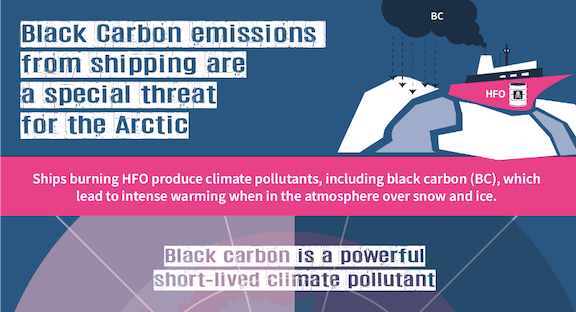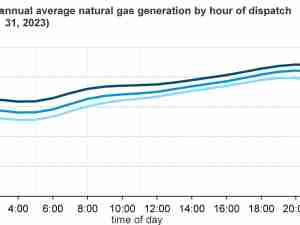Responding to the Arctic Council Reykjavík Declaration signed today by Arctic foreign ministers under the Chairmanship of Iceland, the Clean Arctic Alliance noted the Arctic Council’s plans to “update” its ambitious black carbon target agreed in 2017, but expressed frustration that the Arctic Council has not done more to prioritize reducing black carbon emissions from shipping.
“While we welcome the progress by Arctic Council members to reduce black carbon emissions in the region, along with the intention expressed in today’s Reykjavík Declaration to further develop this area of the Arctic Council’s work, Arctic governments must take urgent action to address black carbon emissions from shipping in the Arctic, which saw an 85% increase between 2015 - 2019”, said Dr Sian Prior, Lead Advisor to the Clean Arctic Alliance.

“The Clean Arctic Alliance is concerned that the Reykjavík Declaration contains no recognition of the impact of black carbon emissions from shipping or the urgent need to accelerate the implementation of the ban on use and carriage of heavy fuel oil in the Arctic”, she continued. “Banning HFO in the Arctic and moving to cleaner distillate fuels would result in an immediate 30% reduction in black carbon emissions from shipping.”
The Arctic Council’s Expert Group on black carbon and methane has recommended the need to accelerate efforts to mitigate black carbon from international shipping and implement measures to mitigate black carbon from domestic shipping activities.
“The Clean Arctic Alliance urges the Arctic states and Arctic-observer states, under Russia’s Chairmanship, to act on this recommendation by delivering on the Council’s black carbon target, in relation to the shipping sector, by calling for action to be taken by the International Maritime Organization's forthcoming Marine Environmental Protection Committee, which meets next month”, continued Prior.
Norway has recently taken a bold step and is leading the way on getting HFO out of the Arctic, by extending an existing ban on HFO in the waters surrounding Svalbard, which will require the use of alternative, cleaner fuels and stop all HFO use and carriage in the area.
“On May 19, the Icelandic Parliament adopted a resolution calling for an end to ‘burning of HFOs in shipping’. Given the Declaration adopted today, Iceland has to significantly step up its game and match the leadership demonstrated by Norway”, said Árni Finnsson, chair of the Iceland Nature Conservation Association (INCA).
The Clean Arctic Alliance, an international coalition of 22 non-profit organisations had this week called on Arctic foreign ministers to demonstrate global leadership by agreeing to cut black carbon emissions from shipping and to take effective action on Arctic-wide elimination of heavy fuel oil, ahead of next month’s the International Maritime Organization’s (IMO) Marine Environment Protection Committee meeting (MEPC 76).
“Arctic States must also take action to mitigate the impacts of HFO and black carbon emissions from domestic shipping activities”, concluded Prior.
Background
In November 2020, more than ten years after the Arctic Council first concluded that oil spills are the greatest risk posed by shipping, the IMO agreed to ban the use and carriage of heavy fuel oil (HFO) in the Arctic [8]. The IMO is due to make a final decision on the ban on the use and carriage of heavy fuel oil during its meeting of the Marine Environment Protection Committee (MEPC76, June 10-17), and will also consider a proposal for a resolution addressing black carbon emissions from ships. As currently drafted, the IMO’s proposed Arctic HFO ban will not be fully effective until mid-2029; with black carbon emissions from ships likely to continue to grow in the meantime, and the risk of HFO spills will remain.
By switching vessels operating in the Arctic currently using HFO to readily available cleaner fuels, or to alternative forms of propulsion, black carbon emissions from Arctic shipping can be quickly reduced by around 30%. Use of diesel fuel along with the installation of particulate filters or precipitators, as prescribed for other forms of transport, can reduce emissions of black carbon by over 90%.
Around the world, ships typically burn the cheapest and dirtiest fuel left over from the oil refining process – heavy fuel oil (HFO), which produces high levels of black carbon when burned. In January 2020, a new fuel standard was introduced by the IMO requiring ships’ fuels to contain no more than 0.5% sulphur leading the development and use of so-called very low sulphur fuels (VLSFOs).
When ships burn HFO, they produce black carbon particles, which are emitted into the environment via their exhaust fumes. These short-lived climate forcers contribute to the warming of the Earth’s atmosphere and when they fall on snow, or on glacier ice and sea ice, their warming impact is 7-10 times greater than on land, as the reflectivity (albedo) is reduced, and consequently the absorption of heat increases. About 7-21% of global shipping’s climate warming impacts can be attributed to black carbon – the remainder being CO2. Black carbon emissions from shipping have already increased by 85% between 2015 and 2019, and more Arctic shipping using HFO will lead to further increases in black carbon emissions, fueling an already accelerating feedback loop [11]. The IMO’s HFO ban will only reduce the volume of black carbon emissions by a mere 5% when it enters into force in July 2024].
Although shipping only contributes 2% of the black carbon in the Arctic, it has a much greater heating impact, as other sources of black carbon are higher in the atmosphere with less chance of falling on ice and snow. While most anthropogenic sources of black carbon pollution are being reduced in the Arctic, shipping emissions of black carbon have risen 8% globally in the past decade, and in the Arctic by 85% between 2015 and 2019 alone [12]. With climate warming driving the ongoing loss of multi-season Arctic sea ice, the region is opening up to more shipping traffic; between 2013 and 2019 data published by the Arctic Council showed a 25% increase in shipping traffic and a 75% increase in the total distance sailed in the Arctic, we can expect that further increases in black carbon emissions from shipping will only further contribute to an already accelerating feedback loop.
In November 2020, the International Maritime Organization (IMO), the UN body which governs shipping, approved a ban on the use and carriage of HFO in the Arctic – a ban that is set to be adopted this June. Although environmental and Indigenous groups had fought for years for the Arctic to be free of HFO, this ban set to be agreed in a few months contains serious loopholes which will mean minimal reductions in the use and carriage of HFO in 2024 when implemented. Meanwhile current growth in Arctic shipping is likely to lead to an increase in HFO use and carriage in the Arctic between now and mid-2024 when the ban takes effect and further growth by mid-2029, when the loopholes will finally be closed. Under this regime, black carbon emissions are likely, for now, to continue to increase in the Arctic.









